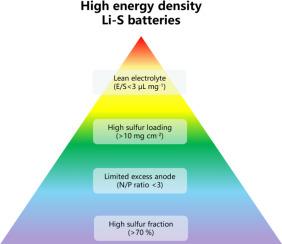锂硫电池商业化的进展
IF 9.2
2区 工程技术
Q1 ENERGY & FUELS
引用次数: 0
摘要
锂硫电池已经成为下一代可充电储能系统的一个有前途的候选者,它具有几个优点,如理论上更高的能量密度、更低成本的活性材料,以及由于缺乏镍、钴和锰等关键金属而带来的环境效益。然而,尽管学术界和工业界都做出了大量的研究和开发努力,但锂硫电池的商业化仍然受到许多重大挑战的阻碍。这些问题包括硫阴极的绝缘性质,有机醚基电解质中的有害多硫化物穿梭效应,以及锂阳极上的枝晶生长。在实验室规模的(硬币电池)锂硫电池和在更大的工业规模(袋式电池)系统中取得的进展之间存在着显著的差异。为了解决这一差距,研究人员必须把重点放在扩大生产工艺、提高材料稳定性和优化电池设计上,以满足工业应用的严格要求。本综述旨在强调当前阻碍锂硫电池实际部署的关键技术和材料相关挑战,同时也概述了锂硫袋电池技术的最新进展以及正在进行的商业化工业努力。本文章由计算机程序翻译,如有差异,请以英文原文为准。

Advances in lithium‑sulfur batteries for commercialization
Lithium‑sulfur batteries have emerged as a promising candidate for next-generation rechargeable energy storage systems, offering several advantages such as theoretically higher energy density, lower-cost active materials, and environmental benefits due to the absence of critical metals like nickel, cobalt, and manganese. However, despite considerable research and development efforts from both academia and industry, the commercialization of lithium‑sulfur batteries remains hindered by a number of significant challenges. These include issues such as the insulating nature of the sulfur cathode, the detrimental polysulfide shuttle effect in organic ether-based electrolytes, and dendritic growth on the lithium anode. A notable discrepancy exists between the progress made in laboratory-scale (coin cell) lithium‑sulfur batteries and that achieved in larger industrial-scale (pouch cell) systems. To address this gap, it is essential for researchers to focus on scaling up production processes, enhancing material stability, and optimizing battery designs to meet the stringent requirements of industrial applications. This review aims to highlight the critical technical and material-related challenges that currently impede the practical deployment of lithium‑sulfur batteries, while also providing an overview of the latest advancements in lithium‑sulfur pouch cell technology and the ongoing industrial efforts toward its commercialization.
求助全文
通过发布文献求助,成功后即可免费获取论文全文。
去求助
来源期刊

Sustainable Materials and Technologies
Energy-Renewable Energy, Sustainability and the Environment
CiteScore
13.40
自引率
4.20%
发文量
158
审稿时长
45 days
期刊介绍:
Sustainable Materials and Technologies (SM&T), an international, cross-disciplinary, fully open access journal published by Elsevier, focuses on original full-length research articles and reviews. It covers applied or fundamental science of nano-, micro-, meso-, and macro-scale aspects of materials and technologies for sustainable development. SM&T gives special attention to contributions that bridge the knowledge gap between materials and system designs.
 求助内容:
求助内容: 应助结果提醒方式:
应助结果提醒方式:


